-

人教版高中英语必修2Wildlife Protection说课稿3篇
When it comes to the students’ studying methods, I'd like to introduce my Ss first. The Ss have a good command of basic language points. They’re interested in learning English, and they take an active part in English class, so they will have fun in autonomous, cooperative and inquiry learning. I will just serve as a guide, showing them the way to explore how to make more progress in their English learning.Now it’s time for the most important stage of this lesson. My teaching procedures are arranged as follows:Step1.Leading-in (3 minute)Play a video of a wide variety of wildlife to introduce my topic. Step2. Speaking (12 minutes)We will use our textbook Page25. Let the Ss fast read the short paragraph to warm up. Ask them to talk about the report on some endangered wildlife in China with the dialogue patterns on the screen. Lastly, I will invite some groups to demonstrate their dialogues about saving wildlife in China.Step3.English play (3 minutes)Watch another video in praise of their excellent performance just now. It’s about Jack Chen’s(成龙)and Yang Ziqiong’s wildlife protection.Step4. Listening (twice 13 minutes)This time, I’ll ask the Ss to fill in the blanks of the monologue of the 2 movie stars above. Step5.Discussion (3 minutes)Which would you like to choose to wear, clothes made of cotton, artificial leather or animal skins? Why ?Step6. Summary (3 minutes)1. If there were no wildlife, there wouldn’t exist human beings. If the buying stops, the killing can, too.2. Animals are our friends. To love animals is to love ourselves. Stop hunting, killing and destroying wildlife.3. Let’s live in harmony with all the living things in the world. Step7. Music appreciation (3 minutes)Let the Ss appreciate the song Earth Song by Michael Jackson. Last but not the least, I will show you my blackboard design.

人教版高中英语必修4A taste of English Humor说课稿3篇
Then I would ask them to think of a funny English or Chinese and tell it to partners. While telling stories, they can use expressions and some acting to help make the story funny. 5 minutes would be given to do this.Those stories they told there will be the material for their writing. Soletting them tell it at first is helpful. And they can make a difference between telling a funny story and writing it down. Generally speaking, it is difficult forstudents to write well because they don’t know what to write and how to write. Asking them to tell their own stories at first can help them come up with what to write.After their telling, I would invite someone to share his/her story with all of us and I would write it down on the blackboard.This example story would be used as a sample to illustrate the format of funny story. Different from a story from teacher or textbook, a story from students can obviously become a interesting material to draw students’ attention.Then I would ask the whole class to put this story into several parts. It might be a little bit difficult for them. So I would ask them to find out whether all the sentences are necessary. After delete some sentences, there are 6 sentences left behind. Then they can easily put them into three parts. After interaction with students, I would teach them the right terms for each part and conclude the format of funny story.This step is the key and difficult point in my lesson. So I mainly usetask-based teaching method in this part and the task for students was divided into several stages. With the separated difficult level, students can find there are usually three parts in writing. They can also learn to write without the unnecessary parts in the process of analyzing. And then I wouldn’t rush to tell them the right terms to them directly. Instead, I would ask them to name them by their own. A confused mind is better for acquiring knowledge.While-writing:Then I would give students 7 minutes to write down this story, without other requirements.With all the preparations in pre-writing, students’ difficulties were cleared. So it would be much easier for them to write down the story within 7 minutes. There are no other requirements because students’ first writing is actually a drafting. It would be revise and edit several times later. Writing, as a skill

人教版高中英语必修3Festivals around the World说课稿3篇
Teaching plan for Unit 1 book3Good morning, teachers. It’s my great pleasure to be here because I can share my lesson with you and I can learn a lot from it. I’ll begin my lesson from the following four parts, the teaching material, the teaching methods, the studying methods and the teaching procedure.Firstly, let me talk about the teaching material. The content of my lesson is the reading passage festivals and celebrations of Unit 1 Festivals around the world. This passage is about festivals and celebrations. By studying this passage, we’ll enable the students to know that festivals exit everywhere, and many of festivals in different countries celebrate similar ideas. As we all know, the reading passage is the center of each unit. If the Ss can learn it well, it will be helpful to make the Ss learn the rest of this unit.After studying the teaching material, I think the teaching aims are as the followings:1. Knowledge aims:(1) The Ss can master the usage of the important words andexpressions.(2)The Ss can use the __________________ (grammar) in the proper situation.Make students know about the festivals all over the world and the detail of the festivals, such as origin, content, and the date of the holiday festivals.2. Ability aims:(1) Students can talk about festivals and celebrations in English(2) To improve the student’s reading ability, especially their skimming and scanning ability.3. Emotion aims:Make the Ss know about the foreign festivals, and respect other countries’ custom.Next, let’s come to the important points and the difficult points.The important point is how to make the Ss understand the text better and the difficult point is how can they talk about it. secondly, Teaching Methods:1. task-based Language Teaching2. Computer assisted language teaching.3. question-and–answer methodThirdly, Studying Methods:

人教版高中英语必修3Healthy Eating说课稿4篇
Language learning needs a context, which can help the learners to understand the language and then can product comprehensible output, so computer has the advantages to make the materials attractive.Part 3 Learning MethodsTask-based, self-dependent and cooperative learningPart 4 Teaching ProcedureStep One Lead-in“Interest is the best teacher.” Therefore, at the very beginning of the class, I should spark the students’ mind to focus on the centre topic “the band”. I’ll show some pictures of food to attract their attention and then bring some questions.Question:What kind of food they like?What should go into a good meal?The answers must relate to the diet. After this, the students will be eager to know something about a balance diet and this is the very time to naturally lead the class into Step 2Step 2 Reading for information: skimming and scanning In this step, I use Task-based Language Teaching method, which can give students a clear and specific purpose while skimming and scanning the context.Task 1 General ideaThe students will be asked to just glance at the title and the pictures of the passage, and then guess what they will read in the text. And they’ll be divided into groups of four to have a discussion.The purpose is to inspire the students to read actively, not passively. In addition, the task is to develop the students’ reading skill by making prediction and to encourage the students to express their thoughts in English and cooperate with each other.Task 2 Main idea of each paragraphCooperative learning can raise the students’ interest and create an atmosphere of achievement. Based on this theory, I divide the whole class into 4 groups to skim the whole text and get the main idea of each paragraph.

人教版高中英语必修4Working The Land说课稿3篇
Knowledge objectives:(1) to make Ss grasp the usage of words, expressions and sentence structures: statistics, struggle, thanks to, rid of, some patterns for persuasion, the “ing” form as subject and object;(2)to use learnt knowledge to persuade sb.Ability objectives:(1) to develop Ss’ reading skills(skimming, scanning, word guessing);(2) to improve Ss’ speaking, communicating and cooperating skills.Emotional objectives:to make Ss know the contribution of Yuan,and learn his spirit and his simple life time.Teaching important and difficult points:(1) some words, expressions and sentence structures mentioned above;(2)the content of the text;(3)training their reading and speaking skills.Teaching methods: CLT, TBLT,QT.Learning strategies: CLS, QLS, TBLS.Teaching procedures:Step 1 lead-in: (1) teacher plays a piece of recent news from CCTV about the harvest of the super hybrid rice, and ask students whether they know Yuan or not, and talk about him and his contribution.(2)Brain storm: let Ss describe Yuan in their minds including his appearance, his living condition and so on.Step 2 fast reading tasks:(1)teacher introduces Yuan and super hybrid rice(2)make Ss read the text as fast as possible with questions. Such as: what’s the general ideaof this passage? What’s Yuan’ dream? (skimming and scanning skill)Step 3 intensive reading tasks(1)let Ss read the text silently, find topic sentence of each paragraph and draw the difficult sentences and the knowledge what they don’t understand.(words guessing)(2)teacher and Ss talk about the important words, expressions and sentences together, and ask Ss to retell the content of the text.(summarizing and paraphrasing)(3)teacher summarize this part.(4) read again following the courseware.

人教版高中英语必修5Great scientists说课稿4篇
通过写文章梗概,培养学生综合运用语言的能力,学习用恰当的英语描述科学家的故事。这是本课的教学难点。教师可以使用完形填空的方式来帮助学生整理语篇,从而来降低难度。本课的教学重点的突破方法是:在阅读前,让学生初步了解得出科学观点所需要的基本程序,从而轻松而自然地导入文章的阅读;在阅读过程中,由易到难设计快速阅读和精读的问题,层层推进各种阅读活动,让学生对阅读内容从整体感知到细节理解,最后深层读懂整篇文章,同时加强阅读策略的指导,让每个学生都主动参与课堂教学活动,最终达到提高阅读能力的目的。Step 4 Post-readingGroup Activities四人小组共同合作,在老师的适当指导下,就以下2个问题展开讨论,让学生就所知、所学、所感和所想融入话题,然后抽若干同学代表作小组发言。1. What do you think about John Snow, and what should we learn from him?2. Cholera was 19th century disease, which two diseases are similar to cholera today? Why?

人教版高中英语必修5Making the news说课稿4篇
今天我们来介绍一下必修五第四单元的授课方式。这个单元的题目是Making the news。应该是学生比较感兴趣的话题,学生往往对新闻工作充满好奇,所以我们可以利用这个机会多设计一些师生互动和学生互动,来激发起学习的积极性,提高学习效率。同时我们可以利用这个单元不仅帮助学生掌握语言知识,培养语言能力,同时让其了解新闻工作的重要性,培养起社会智能感。这个单元分为六个课时,它的教学目标是这样的:语言目标是掌握词汇表中的常用单词和短语,掌握倒装句的一些基本用法。 技能目标是能初步掌握约会的基本句型并在真实的场景下正确运用。新闻报道类文章的写作技能。采访的基本规范和沟通技能。情感目标是对新闻报道的客观性和真实性有更好的理解。对新闻记者的职业有更深入的了解,并能体会其工作的重要性。下面我们来介绍一下第一课时的授课方式,第一课的教学目标是这样的第一课时的教学目标语言目标:单词:Occupation, journalist, editor, photographer, curious, personality, enthusiasm

人教版高中英语必修5The United Kingdom说课稿4篇
Teaching Aims:Knowledge 1. Get the students to learn the useful new words and expressions in this section. Aims:2. Let the students learn about how the UK was formed and the four groups of invaders.1. Develop students’ reading ability and let them learn different Ability reading skills. Aims:2. Enable students to learn to talk about the United Kingdom and the Union Jack Emotional 1. Let students know more about the UK2. Develop students’ sense of cooperative learning Aims:Teaching Important Points:1. Let the students learn about the countries of the United Kingdom and the Union Jack2. Get the students to read the passage and know about how the UK was formed and the four groups of invaders.3. Have the students learn different reading skills.Teaching Difficult Ponts:1. Develop students’ reading ability.2. Enable students to talk about the United Kingdom and the Union Jack.3. Let students learn how the UK was formed geographically and historically.Teaching Methods:Showing pictures, asking, exercising, listening, reading etc.Teaching Aids:A computer,a projector and a blackboard.Teaching Procedures: 1) Show a map of the world, ask students the following questions:Where is the UK?What’s the full name of the UK?2) Ask the students work in pairs to do the quiz on Page 9.Do you want to test how many things you know about the United Kingdom? Let’s have a small test.Using the map on P9, students answer the following questions:?How many countries does the UK consist of? What are they??England is divided into three main areas. Do you know what they are? 1) Scanning (10Minutes )Let the students hold the questions asked in pre-reading and read the passagequickly and then let them do the following exercise.Join lines to the right answer.
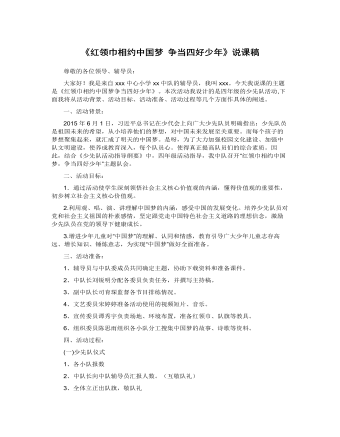
《红领巾相约中国梦 争当四好少年》说课稿
3、展梦想。第三小队通过演讲的形式,展示了自己的中国梦。队员分组通过朗诵诗歌、讲故事和演讲展示自己的中国梦,充分发表自己对社会主义核心价值观的理解,坚定争做四好少年的信心。〖设计意图:社会主义核心价值观比较抽象化,四年级的学生理解起来比较困难,让学生通过表演的形式,在某种程度上视觉感官接受要比抽象图更容易〗第三版块:深入研讨——领悟价值观看各小队表演之后,中队长启发队员们结合自身情况交流学习体会,讨论以下四个问题:(1)观看了视频和同学的表演后,你有什么感想?(2)如何学习树立自己的中国梦?(3)如何用实际行动践行社会主义核心价值观,实现自己的中国梦?让学生结合自身的特点,为自己设定合适的价值观。在此基础上让队员们齐声唱《红领巾心中飘》,道出自己心中的梦想。
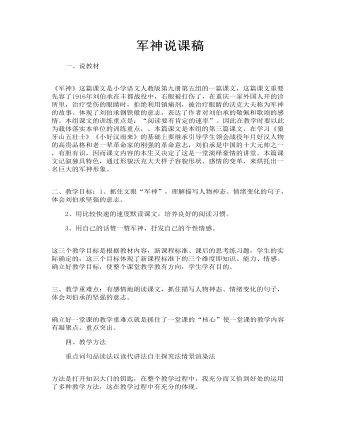
军神说课稿
二、教学目标:1、抓住文眼“军神”,理解描写人物神态、情绪变化的句子,体会刘伯承坚强的意志。 2、用比较快速的速度默读课文,培养良好的阅读习惯。 3、用自己的话赞一赞军神,抒发自己的个性情感。 这三个教学目标是根据教材内容,新课程标准、课后的思考练习题,学生的实际确定的,这三个目标体现了新课程标准下的三个维度即知识、能力、情感。确立好教学目标,使整个课堂教学教有方向,学生学有目的。 三、教学重难点:有感情地朗读课文,抓住描写人物神态、情绪变化的句子,体会刘伯承的坚强的意志。 确立好一堂课的教学重难点就是抓住了一堂课的“核心”使一堂课的教学内容有凝聚点,重点突出。 四、教学方法 重点词句品读法以读代讲法自主探究法情景渲染法 方法是打开知识大门的钥匙,在整个教学过程中,我充分而又恰到好处的运用了多种教学方法,这在教学过程中有充分的体现。
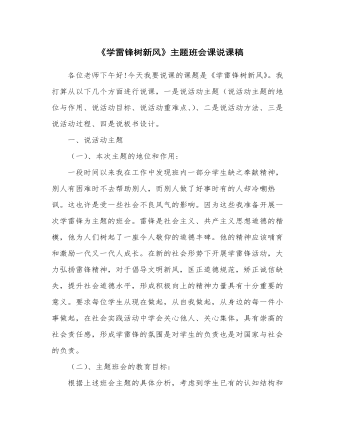
《学雷锋树新风》主题班会课说课稿
2、活动一——雷锋故事会(1)、让同学们展示课前收集的有关雷锋帮助别人的故事。使全体的同学都参与到这个活动中,发挥他们的积极性。(2)、为了丰富教育资源我在此处为学生准备了《可敬的“傻子”》、《雨夜送大嫂》、《人民的勤务员》三个故事,进行补允让学生更加全面的了解雷锋精神。设计此活动的目的是陶冶学生情操,让学生更加深入的了解勤俭朴素、助人为乐、全心全意为人民服务雷锋形象。3、活动二一一读《雷锋日记》让学生读雷锋给一位陌生老人送完手套后写的日记。重点理解“一路上,我的手虽冻得像针扎一样,心中却有一种说不出的愉快。”这一句话。让学生谈谈自己的感受。此活动的目的是让学生了解雷锋的内心世界,理解雷锋精神的实质,全心合意为人民服务。
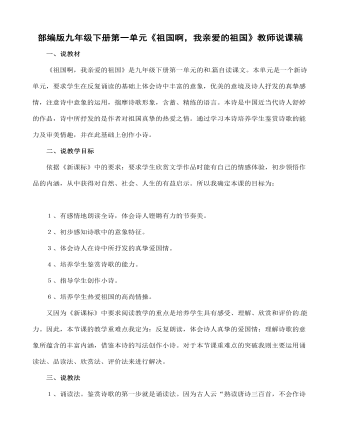
九年级祖国啊我亲爱的祖国说课稿
二、说教学目标 依据《新课标》中的要求:要求学生欣赏文学作品时能有自己的情感体验,初步领悟作品的内涵,从中获得对自然、社会、人生的有益启示。所以我确定本课的目标为:[来源:学_ 1、有感情地朗读全诗,体会诗人铿锵有力的节奏美。 2、初步感知诗歌中的意象特征。 3、体会诗人在诗中所抒发的真挚爱国情。 4、培养学生鉴赏诗歌的能力。 5、指导学生创作小诗。[来源:学科XK 6、培养学生热爱祖国的高尚情操。
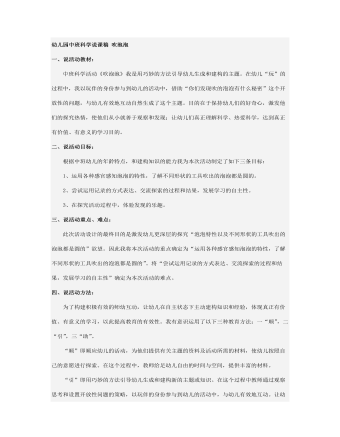
幼儿园中班科学说课稿 吹泡泡
为了构建积极有效的师幼互动,让幼儿在自主状态下主动建构知识和经验,体现真正有价值、有意义的学习,以此提高教育的有效性。我有意识运用了以下三种教育方法:一“顺”,二“引”,三“助”。 “顺”即顺应幼儿的活动,为他们提供有关主题的资料及活动所需的材料,使幼儿按照自己的意愿进行探索。在这个过程中,教师给足幼儿自由的时间与空间,提供丰富的材料。 “引”即用巧妙的方法引导幼儿生成和建构新的主题或知识。在这个过程中教师通过观察思考和设置开放性问题的策略,以玩伴的身份参与到幼儿的活动中,与幼儿有效地互动。让幼儿在“玩”中学,在学中“玩”。 “助”即教师在适当的时候“助”幼儿一臂之力,对幼儿进行点拔,借助当时的情景、材料,直接地提出主题,把幼儿的学习兴趣推向深入。
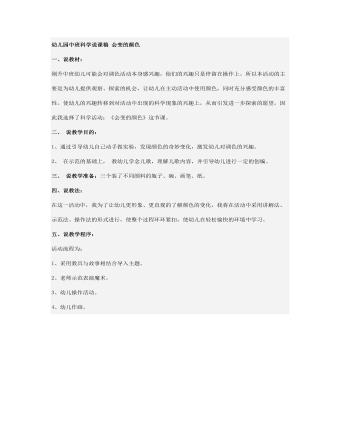
幼儿园中班科学说课稿 会变的颜色
刚升中班幼儿可能会对调色活动本身感兴趣,他们的兴趣只是停留在操作上。所以本活动的主要是为幼儿提供观察、探索的机会,让幼儿在主动活动中使用颜色,同时充分感受颜色的丰富性。使幼儿的兴趣转移到对活动中出现的科学现象的兴趣上,从而引发进一步探索的愿望。因此我选择了科学活动:《会变的颜色》这节课。
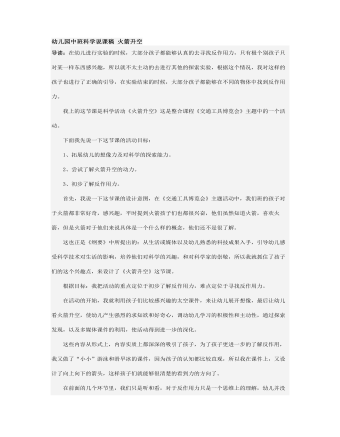
幼儿园中班科学说课稿 火箭升空
在幼儿进行实验的时候,大部分孩子都能够认真的去寻找反作用力,只有极个别孩子只对某一样东西感兴趣,所以就不太主动的去进行其他的探索实验,根据这个情况,我对这样的孩子也进行了正确的引导,在实验结束的时候,大部分孩子都能够在不同的物体中找到反作用力。 我上的这节课是科学活动《火箭升空》这是整合课程《交通工具博览会》主题中的一个活动。 下面我先说一下这节课的活动目标: 1、拓展幼儿的想像力及对科学的探索能力。 2、尝试了解火箭升空的动力。 3、初步了解反作用力。 首先,我说一下这节课的设计意图,在《交通工具博览会》主题活动中,我们班的孩子对于火箭都非常好奇,感兴趣,平时提到火箭孩子们也都很兴奋,他们虽然知道火箭,喜欢火箭,但是火箭对于他们来说具体是一个什么样的概念,他们还不是很了解。
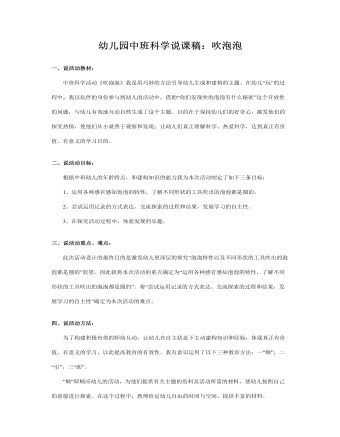
幼儿园中班科学说课稿:吹泡泡
二、说活动目标: 根据中班幼儿的年龄特点,和建构知识的能力我为本次活动制定了如下三条目标:1、运用各种感官感知泡泡的特性,了解不同形状的工具吹出的泡泡都是圆的。2、尝试运用记录的方式表达、交流探索的过程和结果,发展学习的自主性。3、在探究活动过程中,体验发现的乐趣。三、说活动重点、难点: 此次活动设计的最终目的是激发幼儿更深层的探究“泡泡特性以及不同形状的工具吹出的泡泡都是圆的”欲望。因此我将本次活动的重点确定为“运用各种感官感知泡泡的特性,了解不同形状的工具吹出的泡泡都是圆的”。将“尝试运用记录的方式表达、交流探索的过程和结果,发展学习的自主性”确定为本次活动的难点。
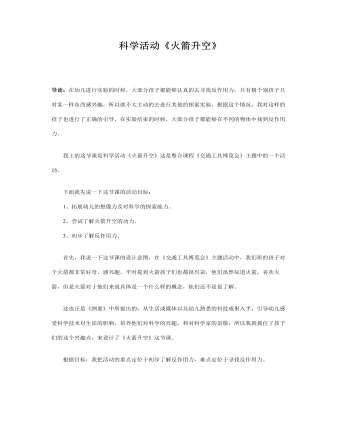
幼儿园中班科学说课稿:火箭升空
我上的这节课是科学活动《火箭升空》这是整合课程《交通工具博览会》主题中的一个活动。 下面我先说一下这节课的活动目标:1、拓展幼儿的想像力及对科学的探索能力。2、尝试了解火箭升空的动力。3、初步了解反作用力。 首先,我说一下这节课的设计意图,在《交通工具博览会》主题活动中,我们班的孩子对于火箭都非常好奇,感兴趣,平时提到火箭孩子们也都很兴奋,他们虽然知道火箭,喜欢火箭,但是火箭对于他们来说具体是一个什么样的概念,他们还不是很了解。 这也正是《纲要》中所提出的:从生活或媒体以及幼儿熟悉的科技成果入手,引导幼儿感受科学技术对生活的影响,培养他们对科学的兴趣,和对科学家的崇敬,所以我就抓住了孩子们的这个兴趣点,来设计了《火箭升空》这节课。
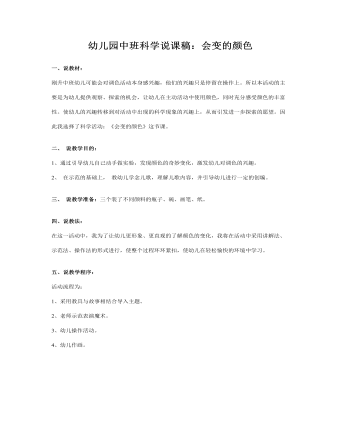
幼儿园中班科学说课稿:会变的颜色
一、说教材:刚升中班幼儿可能会对调色活动本身感兴趣,他们的兴趣只是停留在操作上。所以本活动的主要是为幼儿提供观察、探索的机会,让幼儿在主动活动中使用颜色,同时充分感受颜色的丰富性。使幼儿的兴趣转移到对活动中出现的科学现象的兴趣上,从而引发进一步探索的愿望。因此我选择了科学活动:《会变的颜色》这节课。二、说教学目的:1、通过引导幼儿自己动手做实验,发现颜色的奇妙变化,激发幼儿对调色的兴趣。2、在示范的基础上,教幼儿学念儿歌,理解儿歌内容,并引导幼儿进行一定的创编。
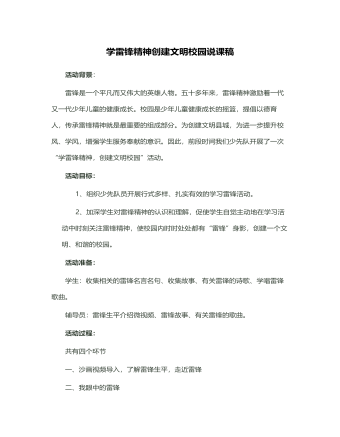
学雷锋精神,创建文明校园说课稿
雷锋精神是什么?这一环节是让学生用简单的词语或句子概括。通过这一活动,让学生概括出雷锋精神的内涵:像无私奉献、乐于助人、为人民服务、勤俭节约、尊老爱幼、勤奋好学、干一行爱一行、言行一致等等都是雷锋精神的体现。我们少年儿童是中国的未来和希望,雷锋精神的发扬和光大,创建文明校园的任务就落在他们的肩上,所以在这里我还设计了为发扬雷锋精神,创建文明校园“我该怎么做”这样的问题,目的就是让他们一起行动起来,学雷锋做好事,并制作了“荣誉”旗,奖励身边的好人好事。活动延伸:这里我设计了一个角色游戏活动——我要义卖献爱心,这个游戏学生们表现得非常积极,他们收集了自己不要的小文具或小玩具,将他们拿到集市上去卖,卖东西获得的钱,捐给王奶奶的孙女,因为王奶奶的孙女生病了,无钱治病。我觉得这个游戏使学生们懂得,一个人只要有爱心,只要愿意去帮助别人,无论什么方式都行,而且在游戏活动中孩子们体会到了帮助别人是一件多么多么快乐的事呀。
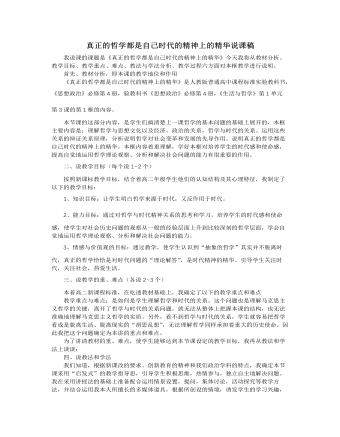
人教版高中政治必修4真正的哲学都是自己时代的精神上的精华说课稿
2、讲授新课:(35分钟)通过教材第一目的讲解,让学生明白,生活和学习中有许多蕴涵哲学道理的故事,表明哲学并不神秘总结并过渡:生活也离不开哲学,哲学可以是我正确看待自然、人生、和社会的发展,从而指导人们正确的认识和改造世界。整个过程将伴随着多媒体影像资料和生生对话讨论以提高学生的积极性。3、课堂反馈,知识迁移。最后对本科课进行小结,巩固重点难点,将本课的哲学知识迁移到与生活相关的例子,实现对知识的升华以及学生的再次创新;可使学生更深刻地理解重点和难点,为下一框学习做好准备。4、板书设计我采用直观板书的方法,对本课的知识网络在多媒体上进行展示。尽可能的简洁,清晰。使学生对知识框架一目了然,帮助学生构建本课的知识结构。5、布置作业我会留适当的自测题及教学案例让同学们做课后练习和思考,检验学生对本课重点的掌握以及对难点的理解。并及时反馈。对学生在理解中仍有困难的知识点,我会在以后的教学中予以疏导。
